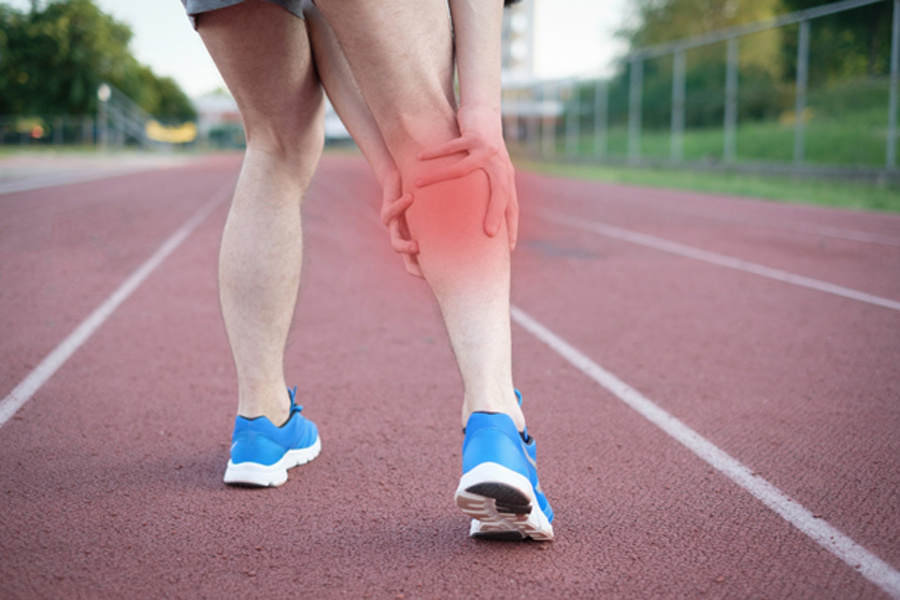Marathon Training Academy

Getting Real About Running Injuries
 In this podcast episode I answer a question from a discouraged runner and share statistics, tips, and hope on dealing with an injury so you can keep doing what you love.
In this podcast episode I answer a question from a discouraged runner and share statistics, tips, and hope on dealing with an injury so you can keep doing what you love.
Many of the episodes that we do are inspired by emails and feedback that we get from listeners.
The question that prompted the topic of dealing with injury came in from Megan who asks,
“Question for Angie. She’s been dealing with a hamstring injury. I’m curious if she in hindsight feels like she did something wrong that could have prevented this injury.. . For someone who has all the tools and knowledge to prevent injury like you guys, to still get injured is disheartening to me. I like to think if you’re smart, you can be an injury free runner, but I guess that’s not the case. I’m dealing with a debilitating posterior tibial tendon disfunction that will likely never go away.” -Megan.
Getting Real About Running Injuries
Sponsored Links:
The Richmond Marathon -They also offer a half marathon and 8k. Register now at www.RichmondMarathon.org
InsideTracker: Their cutting-edge algorithmic engine will analyze your blood, DNA, and lifestyle habits, and guide you to your goals with actionable recommendations. Get 25% off the entire InsideTracker store with our link!
Athletic Greens. Get a FREE 1 year supply of immune-supporting Vitamin D AND 5 FREE travel packs with your first purchase.
The Resilient Runner Program from Dr. Ben Shatto. -The Resilient Runner Program is designed to help you discover how to prevent and self-treat running injuries so that you can continue to train and meet your goals. It includes in-depth videos, tutorials and downloadable training lessons that will help you put the smack-down on injury.
Battling My Hamstring

Walking the second half because of my hamstring
First of all, we’re very sorry that Megan is going through this long-term injury. I can definitely sense the frustration and discouragement that she’s been dealing with. I wish that there was a magic formula that we could follow to avoid all injury. Unfortunately, like most things in life, there isn’t a one-size fits all prescription to be 100% injury free even if you’re a running coach and podcast about marathon training.For those listeners who are not familiar with the hamstring injury that she’s referring to I’ll give a summary for some context. Back in Sept. 2020 I did a 50 mile race and started having left upper hamstring pain halfway through.
I continued the race with a combination of running and walking but the hamstring got progressively more painful, cramped up completely, and was very stiff. I guess the safest thing would have been to drop out of the race at that point but I decided to finish (maybe that’s where the hindsight would play in).
I had about a week of hamstring discomfort post race. After the pain disappeared I resumed running and everything seemed normal. But anytime I ran further than 16 miles at a time the hamstring would act up again.
Realizing that I needed to be more intentional about healing up this area I tried a combination of things including modifying my running routine, massage, cold laser therapy, and physical therapy. In PT we worked on mobility and hip and hamstring strength and I felt a lot better.
After a rocky build up to the Boston Marathon I saw a sports medicine doctor who was supportive of me doing the race. The 2021 Boston Marathon went better than I expected. I felt back to my baseline abnormal/normal within a week and a couple weeks later had a MRI.
MRI and PT Results
The MRI was of the left hip and it showed the following: minimally displaced tear of the anterior superior labrum, underlying subchondral cystic change at the acetabular rim (indicative of osteoarthritis), and proximal hamstring tendinosis.
My doctor explained that the labral tear wasn’t the cause of my symptoms and not anything to worry about (apparently it’s fairly common). In his opinion the degree of hamstring tendinosis was not anything to prevent me from running (which was good news).
My recovery would depend more on the dosage of running, type of route (hills will exacerbate it), and listening to my body. He said that tendon issues are a fairly common injury for runners age 40+ because our tissues are less hydrated and less elastic and slower to recover. That’s why building in the appropriate kind and amount of recovery is even more important as we get older.
After that diagnosis I started another course of PT and my goal was to get the inflammation down (through dietary measures, supplements, temporarily reducing my running) and to continue to strengthen my hips, glutes, and hamstrings.
So far in physical therapy (PT) I’ve had some Graston treatments done, active release therapy, and we’ve done some targeted stretching and strengthening.
Something Unusual
During one of my PT sessions one of the physical therapists noticed something unusual with my walking gait and referred me to a PT who specializes in gait assessments. I had a walking assessment done at first and she showed me how I fail to roll through my big toe with my left foot which could be contributing to my left hamstring having to work harder.
I now have several exercises to address this issue and have done a running assessment which showed the same thing.
Overall I’m happy that it’s not an injury that requires me to stop running. On the other hand it’s also frustrating because there’s no certain fix. This recovery is going to be a prolonged effort with no guarantee that I’ll ever be completely pain free. But thankfully I did a hilly 14 mile long run last week and my hamstring held up well.
Getting Real About Running Injuries
When we talk about injury it can be a very broad topic because there are so many different issues that come up and degrees of dysfunction.
What is an acute injury?
Acute injuries happen suddenly, such as a fall, sprained ankle, torn Achilles tendon, broken toe, or pulled back or neck muscle. You can point to a very specific incident as the start of your injury. Interestingly enough, many acute injuries in runners don’t happen while running. That’s why acute injury often seems so capricious.
What is a chronic injury?
Chronic injuries develop over a longer period of time and may also be referred to as overuse injury. At first you may notice some mild pain or dysfunction that pops up occasionally. Then it may progressively become more common or get worse. Chronic issues often respond well to a short period of rest but will often return without proper treatment.
Who gets injured?
I wish there was some kind of guarantee that injury wouldn’t occur if you followed a list of injury prevention techniques. Unfortunately that’s not the case. When we look at injury statistics they show that a majority of runners will deal with some type of acute or chronic injury in their running career.
- Various studies show that between 30-65% of recreational (non-professional) runners will get injured in any given year. A recent study by the University of Gothenburg in Sweden found that 46% of runners reported some type of injury over the course of a year.
- Jay Dicharry, in the book Anatomy for Runners, states that 82% of runners get injured over the course of their running careers.
Although it’s hard to pinpoint the exact numbers the statistics are not encouraging. The two most vulnerable times for injury seem to be the first year of running and when you’re a master’s runner. Women are also at higher risk because of weaker hip stability and a laxer musculoskeletal structure (to accommodate childbirth).
Let’s talk about new runners and aging runners a bit.
New runners:
The prevalence of injury is higher during the first year of running as your body adapts to the demands of training. When people start running there’s often a tendency to do too much too soon.
You may get inspired by the feeling of progress and want to do more and more. Unfortunately our cardiovascular fitness often develops before the bones, tendons, ligaments, and muscles are fully adapted.
A Runner’s World article about injury risk in recreational runners highlighted a study published in the Journal of Orthopedic & Sports Physical Therapy,
“The most common [injury] locations were the knee—accounting for 27 percent of all injuries—[followed by] the Achilles tendon and calf area, representing about 25 percent of all injuries. Those with a previous injury were almost twice as likely to sustain a running-related injury as those without one…”
Unfortunately a running injury early in your running journey may result in further injuries down the road unless you develop a practice of injury prevention. As someone who is injury prone I know that it’s tempting to get lax about doing the accessory work of staying injury free when you no longer have the nagging issue. I’m definitely not perfect in that regard.
Older runners:
The occurrence of injury is also higher for master’s runners because of things like decreased tissue flexibility, loss of muscle mass, and the need for more recovery. The aging process results in decreased blood supply and fewer reparative cells.
Physical Therapy doctor Ben Shatto says,
“Age seems to play a role as to which type of injury one may be prone to. For master’s runners (those who are at least 40 years old), there tends to be a higher incidence of soft tissue injuries (particularly to the calf, Achilles tendon, and hamstring muscles). Knee injuries seem to be more common in younger runners. Regardless of age, women are more prone to stress fractures. Research has shown that most running injuries are multifactorial. This means that there is rarely just one cause to the injury. Being aware of the common characteristics and risk factors that may increase your likelihood of injury can help you to be proactive in avoiding injury in the first place!”
If you’re an older runner it may seem unfair that you have an increased risk of injury, especially if you enjoyed a long period of time of being injury free as a younger runner.
It’s also very common that new runners are above age 40 which doubles the risk. That’s why it’s important to build in healthy habits early in your running life no matter when you start.
Another important thing to emphasize if you’re an older runner is to not rush the process of building a solid running base before taking on more challenging goals. Your body simply needs more time to adapt.
What do we mean by the term “injury free”?
Because injuries are so common being injury free often becomes the ultimate goal for long term runners. And we often talk about those “bulletproof” runners with a special kind of awe.
Some runners seem to be able to do high volume, high intensity, and rarely take time off. Although I’ve noticed that many of those runners do end up dealing with injury as they age.
When we talk about being injury free this doesn’t mean that you’ll never get injured. It means catching issues early and working to heal problems and get stronger. There’s also a big difference between injuries where you can’t run and have to take an extended period of time to heal and injuries where you can still run but you’re prevented from reaching a certain goal within your desired time frame.

One big cause of chronic injuries is denial
When we’re in the pursuit of a goal, dealing with injury is inconvenient. We’d rather keep training and hope it goes away on its own (and some issues do). There can be a fine line between living in denial/wishful thinking about a problem and being paranoid about every ache or pain.
It’s important to evaluate whether what you’re dealing with is an injury or not. And we’re often not very good at taking emotion out of the equation and thinking realistically about the problem.
To combat the problem of denial remember that pain is simply information (and information is power). Long distance running has a way of revealing underlying weaknesses in your body. And everyone from the most casual runner to Olympians all have weaknesses.
When it comes to pain, listen to your body
When you’re dealing with an issue it can be helpful to know whether the pain is an injury or not. This article by Dr. Ben Shatto is very helpful when thinking through pain. He answers the question: Is this pain an injury or not?
Your body is sophisticated and complicated. Its ability to signal injury in the form of discomfort and pain cannot be underestimated. Pain is a potential warning signaling a problem. If we listen carefully enough, our bodies will inform us of our ailments. When it comes to knowing if we’re injured or not, we have to listen. Another way to look at it is as a trust, but verify approach. The pain should give you pause.
Look out for any signs of injury
This would include swelling; discoloration; temperature spikes; trouble walking; difficulty placing pressure on the painful area; change in running gait, and sensitivity to touch. These are all indicators that something is wrong and a more formal diagnosis and rehabilitation approach may be indicated.
How long does the pain last?
If you feel pain for long durations of time (hours to days versus minutes), something is most likely wrong. Don’t make the mistake of believing your pain will disappear on its own. Listen to your body and make a decision to address the pain. Don’t continue to ignore it.
Does it improve on its own?
If you find that the pain is not improving on its own and you are experiencing other symptoms of injury (such as swelling, tenderness, and/or changes in movement patterns), then it’s time to figure out exactly what type of injury you’ve sustained.
Is this an overuse injury that has slowly creeped up on you? Was pain caused by a specific episode such as a fall? Start by analyzing the types of activities you’ve performed. Think about when the pain occurs and what activities the pain is associated with.
Be cognizant that most running related injuries are overuse (chronic) in nature. This means that there is likely an exacerbating mechanical cause. The actual painful structure may or may not be associated with the root cause of the injury. Often, overuse injuries are due to a muscle or strength imbalance somewhere else in the kinetic chain which can lead to pain and injury in different areas. This can also be true when poor running mechanics lead to pain or dysfunction.
Should you stop running?
Most runners don’t want to hear that they should stop running. I certainly don’t! If this is something that you want to hear then it’s an indication that you’re probably physically and mentally burnt out and it is a sign that you should take a break and pursue another sport or activity that you enjoy.
Unfortunately, many people advise runners to give up running (sometimes permanently) when they’re injured. This kind of advise can come from family members to medical professionals.
A few years ago I was at a rheumatologist trying to get answers about some joint pain and stiffness that I was having. Once he found out I was a runner he made it clear that running is a terrible activity and that he only recommended walking, yoga, and swimming. 






 Visit Podcast Website
Visit Podcast Website RSS Podcast Feed
RSS Podcast Feed Subscribe
Subscribe
 Add to MyCast
Add to MyCast